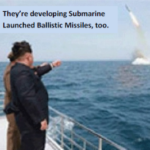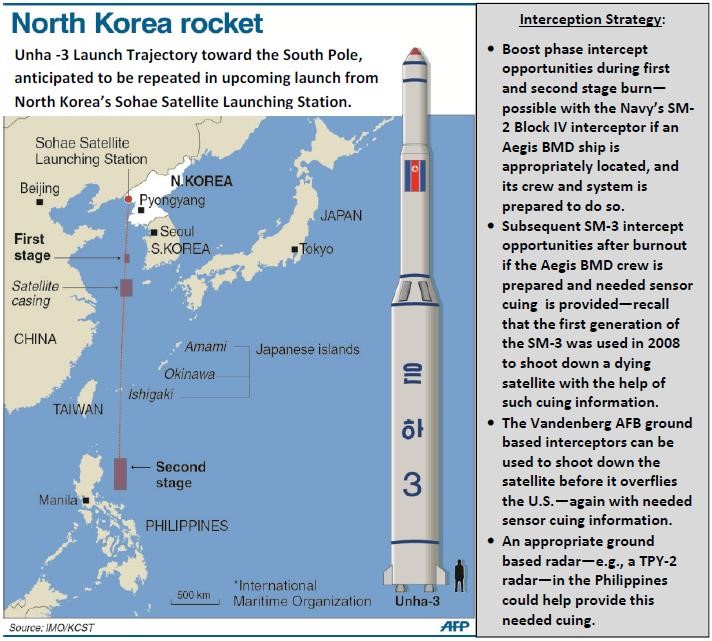“Certainly, we do not want for things to get to a military conflict . . .” but: “If they [North Korean leaders] elevate the threat of their weapons program to a level that we believe requires action, that option [a military response] is on the table.” ~ Secretary of State Rex Tillerson, Reuters, March 17, 2017
Such comments by Secretary Tillerson on his recent trip to Asia signaled a marked change in U.S. diplomacy intended to counter North Korea’s nuclear and ballistic missile development and deployment programs. He said the U.S. policy of “strategic patience” is over and warned that a military response would be “on the table” if North Korea threatened U.S. and South Korean forces.
Click here for an associated March 17, 2017 Reuters report elaborating that, in spite of Tillerson’s warning, other U.S. officials stress that the ongoing review on North Korea policy and contingency planning, including military options, also includes a preference to press Pyongyang to abandon its weapons programs through increased sanctions and other diplomatic pressure, particularly on China. China, of course, urged more “talks” and spokesmen indicated it “resents U.S. pressure to do more on North Korea and says it is doing all it can but will not take steps to threatened the livelihoods of the North Korean people.”
Sounds like “nothing new,” unless President Trump backs-up Secretary Tillerson’s message that captured the headlines. Remember there are literally few, if any, officials at the State Department below Secretary Tillerson from the Trump team and confirmed by the Senate, and “People are policy.”
For about 30 years, U.S. diplomatic efforts, apparently still strongly favored by these presumably “other” U.S. officials, have failed to limit perceptibly this nuclear and ballistic missile threat posed by three North Korean rogue regimes. Click here for my March 14, 2017 discussion of our policies since the 1980s that have failed to diminish or delay in any notable way that now increasingly apparent threat. I elaborated why this “Clueless Dealing with North Korea” illustrates Albert Einstein’s definition of “Insanity: doing the same thing over and over again and expecting different results.”
The current Great Leader, Kim Jong Un — like his father and grandfather before him, has paid little attention to arms control and other diplomatic agreements, like the vaunted nuclear non-proliferation treaty (NPT) regime, which North Korea joined in 1993 and from which it withdrew in 2003. Nor have the economic sanctions that have been imposed in view of North Korean violations and belligerent behavior had any apparent effect. Nor have U.S. entreaties to urge China to restrain its erstwhile partner in trouble making.
As my colleague and friend, Dr. Peter Vincent Pry — the Executive Director of the EMP Commission — has regularly briefed for years, Mr. Kim has long had us squarely in his cross hairs with plans to carry out devastating attacks on the United States. For example, see the chart below from one of his many briefings that provide this warning along with plenty of specifics.
This particular chart is from a briefing he gave at the 2015 South Carolina Palmetto Panel Conference at Clemson University, where we together informed the good people of my home state of the threat posed by credible attacks on our electric power grid that could cause America to lose its electricity for many months, even years. After returning us to a 19th century existence without the benefits of our then less populous agrarian society, most Americans would die within a year. We also recommended actions that should be taken to counter this existential threat; and happily we are undertaking a responsive initiative — more for another message.
It is important to understand that North Korea already has nuclear weapons, a fact many in the press often ignore as they pretend we have a lot of time to respond to provocations from the Great Leader’s actions and bombast. Because of those nuclear weapons and delivery systems, we indeed must exercise care in how we proceed with our activities and consider how they are perceived by Kim Jong Un, lest he or we provoke an unintended disaster.
For example, former CIA Director R. James Woolsey joined Dr. Pry yesterday in a Washington Times article emphasizing the current dangers, particularly if U.S. leaders do not take seriously Kim Jong Un’s threats. To make their point, they recounted a 1983 event that some informed experts believe brought us nearer to a nuclear conflict with the Soviet Union than during the Cuban Missile Crisis. Click here for their article, “The North Korean War Scare,” which argues that we must not dismiss Kim Jong Un’s threats as mere bluster — a view echoing concerns in the Reuters article referenced above.
Woolsey and Pry argue that we must be very careful in the current dual U.S. and North Korean military exercises not to provoke a nuclear exchange, such as the one we now know nearly resulted from our 1983 Able Archer exercise conducted concurrently with our deployment of intermediate range nuclear force (INF) ballistic and cruise missiles in Western Europe to counter the previously deployed Soviet SS-20s. At the time, we took their threats as “bluster” — but later after the end of the Cold War we learned we came close to provoking a Soviet attack on the United States.
North Korea is not (yet) a major nuclear power, as then was the Soviet Union. But it does have a significant number of nuclear weapons — and it already can deploy them against the United States, as noted by Pry’s 2015 chart above and as we both have repeatedly reported over the past several years.
In 1983, the provocation of concern to the Soviets was the deployment of INF missiles in the territory of our NATO allies. Now the provocation of concern to North Korea could be the deployment of our Terminal High Altitude Area Defense (THAAD) theater missile defense (TMD) system on the territory of our ally South Korea.
North Korea’s threat is quite real. Nuclear weapons could be placed on its already demonstrated satellites, like the ones currently in orbit that were launched in 2012 and 2016. They were launched southward from North Korea’s south. If they carried nuclear weapons, they could be detonated over the United States as they arrive from our mostly undefended South.
To execute such an attack, North Korea has no need for hardened reentry vehicles, since the nuclear weapons would be detonated above the atmosphere — hence, North Korea needs no separate development program to threaten an attack on the United States that could lead to the death of most Americans within a year.
This concern is serious and potentially urgent. Today, we have little defense against this urgent threat due to a lack of planning, not of potential capability.
I have argued numerous times that our Aegis ballistic missile defense (BMD) destroyers and cruisers offer ways to provide a near-term defense against this threat — and they should be so empowered to do so as quickly as possible. There are several U.S. and Japanese Aegis BMD ships in the vicinity of North Korea, and they are capable of shooting down short range ballistic missiles (SRBMs), medium range ballistic missiles (MRBMs) and intermediate range ballistic missiles (IRBMs) that could threaten Japan and our troops in the region.
With software improvements, which could be rapidly installed, and with appropriate sensor cues, these same ships could be rapidly upgraded also to shoot down intercontinental range ballistic missiles (ICBMs) and satellites launched from North Korea. Recall that in 2008, President Bush chose an Aegis BMD ship to shoot down a dying National Reconnaissance Office (NRO) satellite that threatened to spread toxic fuel on populated areas.
Check here for a six minute video report on how, only six weeks later, needed software was developed, tested and installed on that Aegis BMD ship successfully that, with needed and innovatively provided additional sensor cuing, executed the President’s mission.
Now, nine years later, couldn’t the Aegis BMD team do this again to defend the American people from North Korea? You think???
Moreover, with other software improvements, the Aegis air defense system can be upgraded to shoot down the satellite launchers as they are rising from their launch pads, provided the ships get close enough to those launch pads.
I have discussed these near term options many times over the past several years, e.g. click here for my September 22, 2015 message, which includes references to earlier messages including the following summary chart from my August 25, 2014 message.
In addition to the alternatives mentioned above, Aegis sensor systems can also help provide tracking information that could help enable the ground-based missile defense (GMD) site on Vandenberg AFB, CA to shoot down a satellite approaching the United States from the south.
And a ground-based radar in the Philippines would be very helpful in providing advance track information to help enable the Vandenberg AFB GMD site. A political challenge, but one that might interest the author of “The Art of the Deal.”
There are also other near-term BMD systems that should be expedited to defend the American people. And we also should be expediting employment of effective passive defense measures — especially to protect the electric power grid from all threats, especially from EMP and cyber weapons as well as from physical attack.
Bottom Lines.
Truly, President Trump should fulfill ASAP his campaign promise in Philadelphia:
“We propose to rebuild the key tools of missile defense, starting with the Navy cruisers that are the foundation of our missile defense capabilities in Europe, Asia and the Middle East. As we expand our Navy toward the goal of 350 ships, we will also procure additional modern destroyers that are designed to handle the missile defense mission in the coming years.”
He is right to emphasize making Aegis BMD all it can be — especially to counter North Korea (and its ally Iran, by the way). He also should reinstate Ronald Reagan’s “streamlined” Strategic Defense Initiative and charge it with building the most cost-effective BMD systems as quickly as possible, beginning with a modern Brilliant Pebbles system within five years.
What can you do?
Join us in praying for our nation, and for a rebirth of the freedom sought, achieved and passed to us by those who came before us.
Help us to spread our message to the grass roots and to encourage all “powers that be” to provide for the common defense as they are sworn to do.
Begin by passing this message to your friends and suggest they visit our webpage www.highfrontier.org for more information. Also, please encourage your sphere of influence to sign up for our weekly e-newsletter.
Encourage them to review our past email messages, posted on www.highfrontier.org, to learn about many details related to the existential manmade and natural EMP threats and how we can protect America against them.
Click here to make a tax deductible gift. If you prefer to mail a check, Please send it to 500 North Washington Street, Alexandria, VA 22314.
Please click here to read Past Weekly Updates!
Please help High Frontier continue this important and timely work!
Be sure to follow us on our Social Sites!
If you found this letter via our Social Sites, and you would like to subscribe, please click below!







